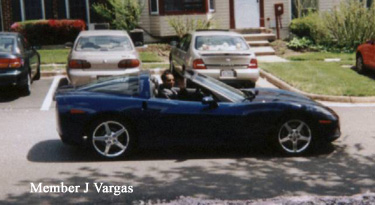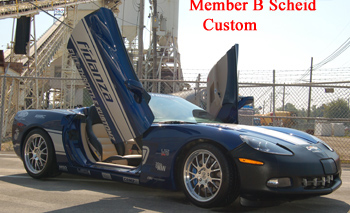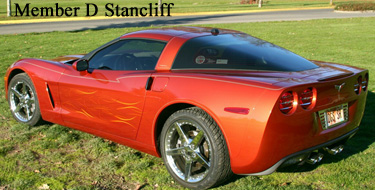 On the outside, the all-new 2005 'Vette is a modern blend of form, function and emotion. The C6 has a new size that makes it a more agile machine, even though it is more powerful than its C5 predecessor. The C6 is 5.1 inches shorter and 1.1 inches narrower than the C5, but has a 1.1-inch longer wheelbase, allowing it to maintain the same interior room and cargo space.
On the outside, the all-new 2005 'Vette is a modern blend of form, function and emotion. The C6 has a new size that makes it a more agile machine, even though it is more powerful than its C5 predecessor. The C6 is 5.1 inches shorter and 1.1 inches narrower than the C5, but has a 1.1-inch longer wheelbase, allowing it to maintain the same interior room and cargo space. Reworking two areas of the C6's front-end architecture enables the overall shortening of the car: The front sections of the hydro-formed rails have been shortened by 2.4 inches (60 mm). The fore-and-aft dimension of the front bumper beam has been shortened by .63-inch (16 mm). The new bumper beam is made from two high-strength-steel C-channels that are seam-welded together. At the rear, the body length is reduced via more effective positioning of energy-absorbing foam and the shortening the rear fascia and bumper structure. The C6's overall dimensions produce a "tighter" package that is similar to a Porsche 911.
"Designing the next Corvette was every designer's dream and a tremendous challenge," says Tom Peters, chief designer of the C6. "Everybody had their personal vision of what a Corvette should look like." Peters said that the concept behind the exterior design was to keep it as fresh as possible, while reflecting the looks of the classic '63-'67 "midyear" Corvettes.
Peter and his team wanted the new car to have an expressive "face," a tense, flexed look, powerful and dramatic arching fender forms, side extractors, round taillights and performance-oriented exhaust tips. "We wanted the C6 to say 'Corvette' at 100 yards," explains chief engineer Dave Hill."
The new, traditional-looking center-mounted egg crate grille is traditional, as well as functional, because the C6 has switched from the C5's "bottom breathing" design to one that takes air in 60-percent from the front and 40-percent from the bottom. The C6 also uses the first exposed headlights seen on a 'Vette since 1962. Peters says designers settled on exposed headlights because they fit the theme for the new Corvette - lean, purposeful and performance-oriented. 
The use of fixed headlights saves weight, reduces complexity and provides better lighting. HID Xenon low-beam projector-beam lenses and tungsten-halogen high-beam projector lenses are used. The projectors are housed in a polycarbonate enclosure that integrates the parking lights, sidemarker-and-turn lights and daytime running lights. Both lenses have chrome rings, but the bottom of the headlight assembly is body-colored for an integrated, upscale look.
The center-bulge hood on the 400-hp C6 implies "muscle power" and radiates outward into the front fenders. The hood opening line falls in the valley where the fender meets the hood. The front fenders are more rounded and more sharply defined. They're a tad higher than the C5 fenders and feature a new beltline crease. The fenders carry down tight against the wheels and retain more definition as they blend into the central fuselage. Combined with the shortened front overhang, the fenders contribute to a tauter, more purposeful front-end design.
The Corvette's traditional "fighter jet" side-profile is continued in the C6. Viewed from above, the "cockpit" styling has been extended to the roof, with more defined dual blisters. "We looked to inspiration from modern jet fighters," said Peters. A new Keyless Access system eliminates exposed door handles and locks.
The wheels used on the C6 are one-inch larger than C5 wheels, measuring 18.0 x 8.5 inches at the front and 19.0 x 10.0 inches at the rear. The rear wheels are also 0.5 inches wider than C5's. The five-spoke flangeless wheels are painted silver, but polished aluminum wheels are optional.
The rear end appearance of the car, while emphasizing the shortened rear overhang, was kept bold and simple. Four round taillights follow a Corvette tradition dating from 1961. The taillight-license plate relationship was taken as an important styling cue for C6 designers. Reflector optics give the illuminated taillights a glow reminiscent of jet afterburners.
 On C6 coupes, the fender shapes emphasize crisper transitions and creases that run all the way to the back of the deck lid, drawing your eyes to the taut body form. A center high-mounted stoplight is integrated into the molded black spoiler located on the rear deck lid. The CHMSL is lit using light emitting diodes.
On C6 coupes, the fender shapes emphasize crisper transitions and creases that run all the way to the back of the deck lid, drawing your eyes to the taut body form. A center high-mounted stoplight is integrated into the molded black spoiler located on the rear deck lid. The CHMSL is lit using light emitting diodes.A diffuser has been to the bottom of the C6's rear fascia to enhance air flow and add visual interest to the rear of the car. Four circular exhaust tips are integrated into the rear diffuser. The tips exit from the center of the diffuser and repeat the circular theme of the taillights. These design elements "frame" the rear of the C6, producing a narrower body cross section and making the car look and measure smaller at the rear.
Eight exterior colors are offered for the C6. Precision Red and Daytona Sunset Orange are new colors. Carryover hues include Le Mans Blue, Millennium Yellow, Magnetic Red, Machine Silver, Artic White and Black.
The C6 uses a forward-hinged hood that is 15 percent smaller, 35 percent lighter and 40 percent stiffer. It closes more easily and securely and eliminates the need for driver checking. At the rear, revisions to the hatchback's hinges, gas struts and bumper stops ensure that the power-operated hatch seals securely every time. A hand-hold has been designed into the hatch's inside bottom edge to make closing it more convenient.
The removable-roof panel used on C6s is 15 percent larger, but has the same stiffness as the C5 type and weighs just one pound more. The roof panel comes standard in body color. It is optionally available in tinted clear or with a dual-roof package. With new indexing side glass and redesigned seals, the roof panel contributes to a quieter interior. A simple three-lever release system makes the panel easier to remove and it snaps in place for easier storage. Small items, bags or briefcases can now be stored underneath the stowed pane.
Thanks to more than 400 hours in the wind tunnel, the C6 has a low .28 drag co-efficient. This was an important aspect of the designing the new body, since the car had a targeted top speed of 180 mph. Reducing lift and increasing stability at high speeds was a critical factor in the car's development. Experience with aerodynamics gained from Corvette's C5-R championship race car really paid off when transferred to the production version C6. The new 'Vette is world class when it comes to the appearance and functionality of its gorgeous exterior. Better yet, its outside beauty also reflects what's below the surface.